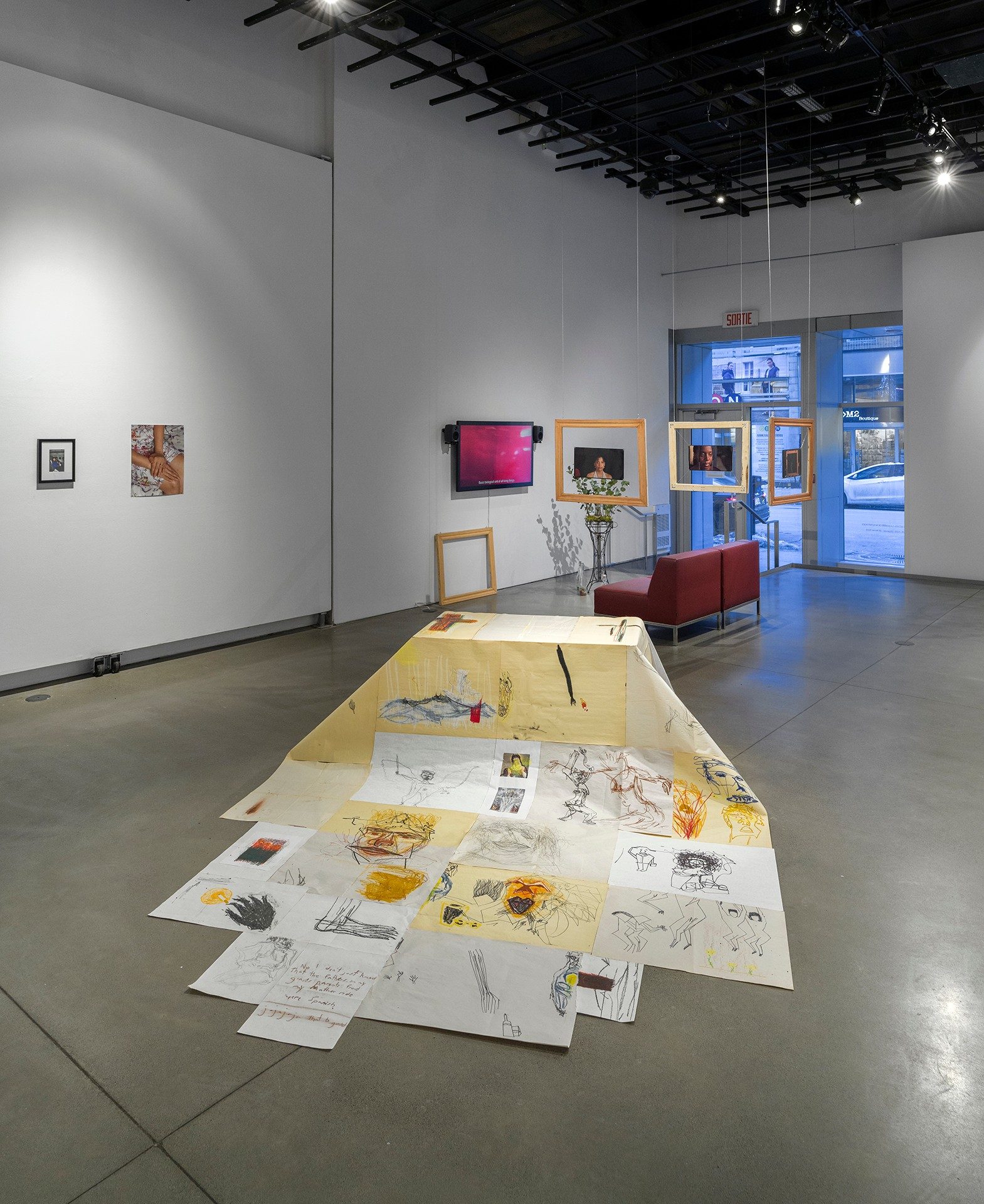RAFA SANTOS
Basement Altar (Altar to Belie Belcan and Anaisa Pye)
2018

Conté, graphite, oil pastel and ink on paper, 8.2' X 9.8' X 16.4' approx.
Artist statement
The installation Basement Altar (Altar to Belie Belcan and Anaisa Pye), refers to Las 21 Divisiones, a syncretic religion native to the Dominican Republic. Revered in the religion are los misterios, African deities represented in image by Roman Catholic saints. The religion combines West African, Taíno and Spanish traditions that have subverted the colonizer’s oppressive binaries on the island since the transportation of the slaves to the New World.
 Photo by Guy L’Heureux
Photo by Guy L’Heureux
Artist’s biography
Throughout their BFA at Concordia University, Rafa Santos has cultivated an interest in the linear and spatial potential of drawing and sculpture. Enigma and irrationality are themes that arise through their practice of renouncing control over aesthetic structure. Their content remains implicit, as if muted by a materiality not imposed. Santos addresses the subject of identity with both a private and a public voice at once. Post-minimalist in their aesthetic, abstraction dominates representation. All that which is depicted in Santos’ work functions as a vessel for memories and emotions: the fleeting and temporal.
 Photo by Guy L’Heureux
Photo by Guy L’Heureux
Essay
Degrees of Separation, Realms of Convergence.
Reflections on an Interview with the Artist, Rafa Santos
Author Matthew Sanderson
Artist Rafa Santos
Artwork Basement Altar (Altar to Belie Belcan and Anaisa Pye), 2018
Basement Altar (Altar to Belie Belcan and Anaisa Pye) by Rafa Santos is a moment of pause; a quiet breath, a silent revelation, a space of grounding. This piece is a synthesis of drawing and installation. It is based on the artist’s creative practice of automatic drawing, and informed by their religious background of Las 21 Divisiones, a syncretic religion native to the Dominican Republic. In an interview with Santos, they shared the rich story of the creation of this piece, as well as their personal reflections on identity, disconnection, the internet, colonization, and how art making serves to navigate these realms.

Photo by Guy L’Heureux
As the eye travels from the base of the altar upwards, the viewer participates in an act of revelation in and of itself.
Basement Altar takes the form of a low, raised platform, across which a tapestry of drawings is spread, stretching forth across the floor. The drawings are executed in pencil, graphite, contée, and ink, resulting in a tone and texture recalling drawing exercises done in the studio on newsprint or in sketchbooks. The drawings are fashioned together seamlessly into a kind of tapestry or quilt: something familiar, personal, and handmade. The drawings contain a rich multitude of imagery, ranging from loosely rendered portraits, gestural figures in lively poses, to more abstract compositions of shape and form. Certain iconic images are particularly striking among the drawings, for instance : a hand reaching for (or perhaps extinguishing?) a cigarette in an ashtray, a handwritten note, and two crosses etched intently into the surface of the paper, flanking the left and right sides of the low platform. At first approach, the viewer is likely to gaze upon the altar from high above, finding the tapestry of drawings at the edges of their feet. However, the rich, intricate details in the drawing and mark-making demands a closer look. In this way, the viewer is asked to bring themselves into the installation, moving closer to the altar. As the eye travels from the base of the altar upwards, the viewer participates in an act of revelation in and of itself.
In this work, Santos is mobilizing a rich synthesis of personal, imaginative, and religiously specific iconography, through an artistic practice of automatic drawing. Looking closely, printed images of Anaisa Pye and Belie Belcan, syncretized as Saint Anne and Saint Michael respectively, are instantly recognizable to those familiar with Las 21 Divisiones, as they are widely celebrated and commonly appear side by side within the household.1 In fact, much of the imagery that emerged through automatic drawing, such as the lively figures and the cigarette, are also aspects of the two Loas. In juxtaposition to the figural images from the artist’s memory and imagination, these printed images were taken from the internet, one of the only means by which Santos has access to their religious, spiritual, and familial roots. Here lies a central, underlying conflict explored in the work: what Santos describes as “degrees of separation,” a fundamental feeling of disconnect that arises as a biracial, nonbinary person under the effects of colonization.2 Ultimately, the intuitive, unrestrained drawings that emerge automatically correspond to these different ‘realms’ of identity, spirituality, gender, and memory. The act of fashioning them together is a physical manifestation of the artist’s desire to reconcile and converge these divergent aspects of themselves.
At 2 a.m. in the studio, Santos experienced a sense of fulfillment and clarity upon the completion of this piece. In this sense, Basement Altar is a personal revelation on the artist’s part that is shared with the viewer in a moment of truth and vulnerability.
- Hector Salva, “Misterios of las 21 divisiones/Dominican Voudou; Los Misterios or Spirits of Las 21 Divisiones,” accessed on July 30, 2021.
- Rafa Santos in conversation with the author, August 2021.
Author’s biography
Matt J Sanderson is an interdisciplinary visual artist. His practice includes painting, drawing, photography, and curation. His work is collaborative, investigative, and meditative in nature. Working in series, he aims to use images as a means of storytelling to navigate themes of queer identity, memory, and found family. As a writer, Sanderson engages with artists through the means of oral history interviews. By sharing the space of an interview, new connections emerge, uplifting the voice of the artist in the process. Matt is the current Exhibition Coordinator for the Art Matters Festival at Concordia University.

